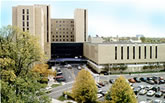Angioplasty.Org recently talked
with Dr. L. Nelson "Nick" Hopkins, Chairman of Neurosurgery,
Professor of Radiology, and Director of the
Toshiba
Stroke Research Center at the
University at Buffalo, State University of New York. Truly
one of the
pioneers in the treatment of stroke, as well as
the non-surgical therapies developed to treat both stroke and
carotid disease, Dr. Hopkins provides a unique perspective
into the
growing area of cross-specialty and multidisciplinary collaboration
between and among medical specialities.
This three-part interview covers a range of topics:
- Part
One discusses the diagnosis and treatment of stroke;
- Part
Two deals with carotid artery disease;
- Part
Three discusses how imaging may impact future treatment,
and how reimbursement questions must be resolved for this
field to move forward.
|
|
 L. Nelson
Hopkins, MD
L. Nelson
Hopkins, MD
University of Buffalo
|
Q: Where do you see hopes of the future of this
field in terms of imaging and treatment of neuro procedures, etc?
Dr.
Hopkins: We work predominantly in the neuro field anywhere from the
upper chest on up, so anything in
the brachiocephalic circulation
is for us an area of focus. I think this field is progressing at
a very rapid rate. I believe that more and better non-invasive imaging
is helping us greatly. I believe that less-invasive procedures are
gradually going to replace the more invasive procedures as we are
able to make them safer and better. In the meantime, we just need
to make sure we get good judgment when we have a patient with carotid
stenosis. It’s really all about judgment at this point; it’s
making the right choice for each individual patient. So I think the
field is fascinating and exciting and the future is I think more
and more going to be less and less invasive. That would be my take.
Q: The growth of the cross-disciplinary
approach seems to be a model that’s going to grow. Are there
incentives or a model can be used?
Dr. Hopkins: I think that there are opportunities
for that to grow. I think there are models beginning to pop up
where there interdisciplinary
teams working together. And I think that hopefully is the future.
We have to get people to put turf aside and realize that there are
so many patients out there with vascular disease. There’s a
role for everyone in all the disciplines that are focused on this
area. And the more we work together, I think the better job we’re
going to do.

Millard
Fillmore Gates Circle Hospital, Buffalo NY |
|
Were working on developing
a multi-disciplinary vascular center here in Buffalo, and were
doing a lot with just cross-training. Right now we have this
artificial division between open surgery and interventional procedures,
and I think that distinction is gradually going to go away.
I
think more and more people in all these disciplines are going
to find that people who take care of patients with vascular disease
are going to be those who can perform both surgery and interventional
procedures or best medical therapy. So we are gradually moving
towards that; its going to take time. |
I think the other very difficult thing is
that Medicare is becoming more and more difficult as a partner,
because if a device is safe
and if it’s proven effective, the FDA tends to approve it.
Then Medicare turns around and says, “Well, that doesn’t
matter to us. What matters is to us is what they call reasonable
and necessary,” so that they require what appears to be a much
higher level of evidence in order for them to begin to pay for a
procedure. So, we have to get FDA and CMS together. I think CMS is
probably being a little short-sighted at this point because the less
invasive procedures are going to be more effective and cost less
in the future, but right now they’re still having problems
accepting FDA approval as a condition for reimbursement. That makes
it tough on everybody.
Q: Recently Medicare changed parameters for carotid
stenting, and another issue with reimbursement for imaging. There
are some who
say that more non-invasive imaging will lead to more and possibly
unnecessary procedures.
Dr. Hopkins: Well, I think that it’s incumbent upon us to
utilize imaging in the most effective way. I think that we are constantly
learning more about imaging, and I think multi-modality imaging is
always better in terms of giving you the total picture of a patient’s
given vascular situation.
If you make a mistake in the treatment of
a patient with vascular disease, the price you pay is extremely
high. Like for example, a
stroke. If you don’t have adequate imaging and therefore you
end up having a stroke because you weren’t able to learn everything
that could’ve helped you, that’s a penny-wise pound-foolish
decision to turn down legitimate requests for imaging.
I think it is reasonable to turn down requests
from people who don’t
normally know how to deal with those images. To think that primary
care docs would be ordering CT angiograms and MR angiograms routinely,
I can understand why Medicare would balk somewhat at that because
they don’t normally use those modalities as much as the people
who are treating the patients. So I think that limiting imaging studies
to those who are capable of using the imaging a little better might
be reasonable. But to deny the imaging I think is potentially hurting
the patient. And if you hurt the patient and the patient has a stroke,
it’s going to cost the federal government a fortune compared
to the cost of that imaging study. So I don’t think it makes
sense to kind of limit non-invasive vascular imaging at this point
in time, we’ve got a lot to learn and every month we learn
something new that helps us.
Q: Thank you, Dr. Hopkins.
For the latest news and information about imaging,
visit Angioplasty.Org's Imaging
and Diagnosis Center.
(return
to Part One)
| This interview was conducted by Burt Cohen of Angioplasty.Org. |
|



